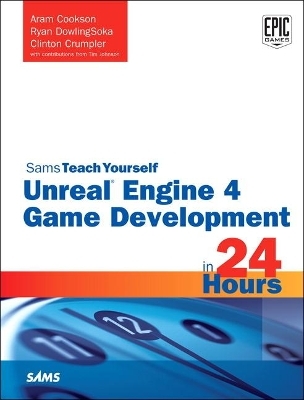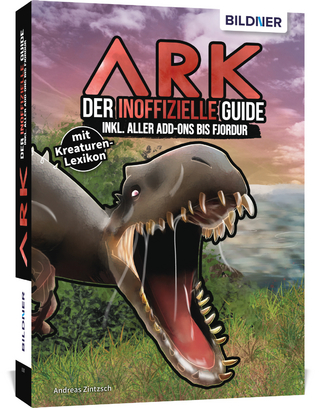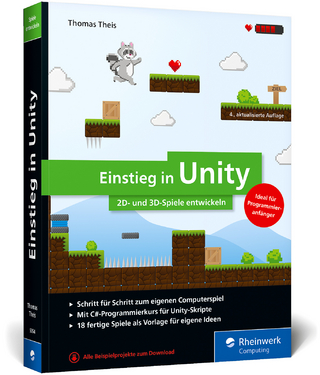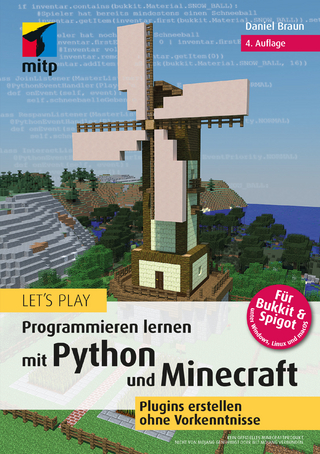
Unreal Engine 4 Game Development in 24 Hours, Sams Teach Yourself
Sams Publishing (Verlag)
978-0-672-33762-8 (ISBN)
In just 24 lessons of one hour or less, learn how to start using Unreal Engine 4 to build amazing games for Windows, Mac, PS4, Xbox One, iOS, Android, the web, Linux–or all of them!
Sams Teach Yourself Unreal Engine 4 Game Development in 24 Hours’ straightforward, step-by-step approach shows you how to work with Unreal Engine 4’s interface, its workflows, and its most powerful editors and tools. In just hours you’ll be creating effects, scripting warfare, implementing physics–even developing for mobile devices and HUDs. Every lesson builds on what you’ve already learned, giving you a rock-solid foundation for real-world success.
Organize new projects and work with the Gameplay Framework
Master Unreal’s units and control systems
Import 3D models and work with the Static Mesh Editor
Create new landscapes and use Unreal’s foliage system
Bring characters and creatures to life with the Persona Editor
Apply materials and build lighting
Integrate and modify audio with the Unreal Sound Cue Editor
Craft particle effects and simulate physics
Set up and react to player inputs
Build levels and entirely new worlds
Get started with powerful Blueprint visual scripting system
Script an arcade game from start to finish
Create events that respond to player actions
Spawn Actors during gameplay
Design and create action-based encounters
Optimize games for mobile devices and touch-based inputs
Build menus with Unreal’s UMG UI Designer
Prepare your game for deployment
Step-by-step instructions carefully walk you through the most common Unreal Engine 4 game development tasks.
Practical, hands-on examples show you how to apply what you learn.
Quizzes and Exercises help you test your knowledge and stretch your skills.
Notes and tips point out shortcuts and solutions.
All the project files and assets you'll need are available for download, including "before-and-after" files demonstrating initial setup and proper completion for every exercise.
Aram Cookson is a professor in the Interactive Design and Game Development (ITGM) department at the Savannah College of Art and Design (SCAD). He has a B.F.A in Sculpture and an M.F.A. in Computer Art. After finishing his M.F.A., he went on to help start the ITGM program and served as the graduate coordinator for 9 years. Over the past 15 years, Aram has developed and taught a range of game art and design courses in classrooms and online, utilizing the Unreal Engine technology. Ryan DowlingSoka is a technical artist working on the Gears of War franchise at Microsoft Studio’s The Coalition, located in Vancouver, British Columbia. He works primarily on content features for the team, crafting systems for destruction, foliage, visual effects, postprocesses, and user interfaces in Unreal Engine 4. Previously, he worked at Microsoft, developing experiences for the Microsoft HoloLens in Unity5. Ryan is an expert in a variety of entertainment software creation packages, including Maya, Houdini, Substance Designer, Photoshop, Nuke, and After Effects. Ryan holds a B.F.A. in Visual Effects from Savannah College of Art and Design. With a passion for interactive storytelling, rooted in playing 1990s console role-playing games ( Baldur’s Gate II and Planescape: Torment), Ryan focuses on applying interactive technical solutions to solving difficult problems in modern gaming. When not working on video games, Ryan can be found swing dancing his evenings away with his wife. Clinton Crumpler is currently a senior environment artist at Microsoft Studio’s The Coalition, located in Vancouver, British Columbia. Previously an artist at Bethesda’s Battlecry Studios, KIXEYE, Army Game Studio, and various other independent studios, Clinton’s primary focus areas are environment art, shader development, and art direction. Clinton has released multiple video tutorials in collaboration with Digital Tutors, with a focus on game art development for Unreal Engine. He completed an M.F.A. in Interactive and Game Design and a B.F.A. in Animation at Savannah College of Art and Design (SCAD) in Savannah, Georgia. Prior to attending SCAD, he received a B.F.A. in Graphic Design at Longwood University, located in Farmville, Virginia. More information and his digital works are available at www.clintoncrumpler.com.
HOUR 1: Introducing Unreal Engine 4 1
Installing Unreal 2
Creating Your First Project 4
Learning the Interface 7
View Modes and Visualizers 14
Playing a Level 16
Summary 17
Q&A 18
Workshop 18
Exercise 19
HOUR 2: Understanding the Gameplay Framework 21
Available Resources 21
Asset References and the Reference Viewer 29
Gameplay Framework 30
Summary 35
Q&A 35
Workshop 35
Exercise 36
HOUR 3: Coordinates, Transforms, Units, and Organization 37
Understanding Cartesian Coordinates 37
Working with Transforms 38
Assessing Units and Measurements 42
Organizing a Scene 45
Summary 50
Q&A 51
Workshop 51
Exercise 52
HOUR 4: Working with Static Mesh Actors 53
Static Mesh Assets 53
Static Mesh Editor 54
Viewing UV Layouts 57
Collision Hulls 59
Static Mesh Actors 66
Summary 73
Q&A 73
Workshop 73
Exercise 74
HOUR 5: Applying Lighting and Rendering 75
Learning Light Terminology 75
Understanding Light Types 76
Using Light Properties 82
Building Lighting 83
Summary 87
Q&A 87
Workshop 87
Exercise 88
HOUR 6: Using Materials 89
Understanding Materials 89
Physically Based Rendering (PBR) 90
Material Input Types 91
Creating Textures 94
Making a Material 96
Summary 105
Q&A 105
Workshop 106
Exercise 107
HOUR 7: Using Audio System Elements 109
Introducing Audio Basics 109
Using Sound Actors 112
Controlling Sounds with Audio Volumes 119
Summary 120
Q&A 120
Workshop 121
Exercise 122
HOUR 8: Creating Landscapes and Foliage 123
Working with Landscapes 123
Sculpting Shapes and Volumes 127
Using Foliage 133
Summary 136
Q&A 136
Workshop 137
Exercise 137
HOUR 9: World Building 139
Building Worlds 140
World Building Process 141
Summary 157
Q&A 157
Workshop 158
Exercise 159
HOUR 10: Crafting Effects with Particle Systems 161
Understanding Particles and Data Types 161
Working with Cascade 162
Using Common Modules 168
Setting Up Materials for Particles 172
Triggering Particle Systems 176
Summary 177
Q&A 177
Workshop 178
Exercise 179
HOUR 11: Using Skeletal Mesh Actors 181
Defining Skeletal Meshes 181
Importing Skeletal Meshes 186
Learning Persona 191
Using Skeletal Mesh Actors 199
Summary 201
Q&A 201
Workshop 202
Exercise 202
HOUR 12: Matinee and Cinematics 203
Matinee Actors 203
Matinee Editor 206
Curve Editor 212
Working with Other Tracks 215
Working with Cameras in Matinee 216
Summary 220
Q&A 220
Workshop 221
Exercise 222
HOUR 13: Learning to Work with Physics 223
Using Physics in UE4 223
Simulating Physics 227
Using Physical Materials 230
Working with Constraints 234
Using Force Actors 239
Summary 241
Q&A 241
Workshop 242
Exercise 242
HOUR 14: Introducing Blueprint Visual Scripting System 245
Visual Scripting Basics 245
Understanding the Blueprint Editor 247
Fundamental Concepts in Scripting 252
Summary 264
Q&A 264
Workshop 265
Exercise 266
HOUR 15: Working with Level Blueprints 269
Actor Collision Settings 271
Assigning Actors to Events 272
Assigning Actors to Reference Variables 274
Summary 284
Q&A 284
Workshop 285
Exercise 286
HOUR 16: Working with Blueprint Classes 287
Using Blueprint Classes 287
The Blueprint Editor Interface 289
Working with the Components 291
Working with the Timeline 296
Scripting a Pulsating Light 300
Summary 307
Q&A 308
Workshop 308
Exercise 309
HOUR 17: Using Editable Variables and the Construction Script 311
Setting Up 311
Making Editable Variables 312
Using the Construction Script 314
Summary 321
Q&A 321
Workshop 322
Exercise 323
HOUR 18: Making Key Input Events and Spawning Actors 325
Why Spawning Is Important 325
Creating a Blueprint Class to Spawn 326
Setting Up the Spawner Blueprint 329
Spawning an Actor from a Class 332
Summary 336
Q&A 336
Workshop 336
Exercise 337
HOUR 19: Making an Action Encounter 341
Project Game Modes 341
Knowing Characters’ Abilities 342
Using Blueprint Classes 344
Actor and Component Tags 350
Summary 351
Q&A 351
Workshop 352
Exercise 352
HOUR 20: Creating an Arcade Shooter: Input Systems and Pawns 355
Identifying Requirements with a Design Summary 356
Creating a Game Project 356
Creating a Custom Game Mode 359
Creating a Custom Pawn and Player Controller 361
Controlling a Pawn’s Movement 365
Setting Up a Fixed Camera 371
Summary 373
Q&A 373
Workshop 374
Exercise 375
HOUR 21: Creating an Arcade Shooter: Obstacles and Pickups 377
Creating an Obstacle Base Class 378
Making Your Obstacle Move 381
Damaging the Pawn 384
Restarting the Game on Death 388
Creating a Health Pickup 391
Creating an Actor Spawner 397
Cleaning Up Old Obstacles 403
Summary 403
Q&A 404
Workshop 405
Exercise 405
HOUR 22: Working with UMG 407
Creating a Widget Blueprint 407
Navigating the UMG Interface 408
Creating a Start Menu 413
Sample Menu System 425
Summary 426
Q&A 426
Workshop 427
Exercise 427
HOUR 23: Making an Executable 429
Cooking Content 429
Packaging a Project for Windows 430
Resources for Android and iOS Packaging 435
Accessing Advanced Packaging Settings 436
Summary 437
Q&A 438
Workshop 438
Exercise 439
HOUR 24: Working with Mobile 441
Developing for Mobile Devices 442
Using Touch 454
Using a Device’s Motion Data 459
Summary 462
Q&A 462
Workshop 463
Exercise 464
Index 465
| Erscheint lt. Verlag | 24.6.2016 |
|---|---|
| Reihe/Serie | Sams Teach Yourself |
| Verlagsort | Indianapolis |
| Sprache | englisch |
| Maße | 188 x 232 mm |
| Gewicht | 781 g |
| Themenwelt | Informatik ► Software Entwicklung ► Spieleprogrammierung |
| ISBN-10 | 0-672-33762-2 / 0672337622 |
| ISBN-13 | 978-0-672-33762-8 / 9780672337628 |
| Zustand | Neuware |
| Haben Sie eine Frage zum Produkt? |
aus dem Bereich


